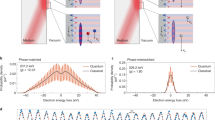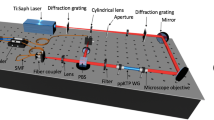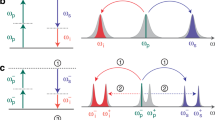Abstract
Sources of photons with controllable quantum properties such as entanglement and squeezing are desired for applications in quantum information, metrology and sensing. However, fine-grained control over these properties is hard to achieve, especially for two-photon sources. Here we propose a mechanism for the controlled generation of entangled and squeezed photon pairs using superluminal or accelerating modulations of the refractive index in a medium or both. By leveraging time-changing dielectric media, where quantum vacuum fluctuations of the electromagnetic field can be converted into photon pairs, we show that energy and momentum conservation in multimode systems give rise to frequency and angle correlations of photon pairs controlled by the trajectory of index modulation. In our examples, these radiation effects are two-photon analogues of Cherenkov and synchrotron radiation by moving charged particles such as free electrons. We find that synchrotron-like radiation into photon pairs exhibits frequency correlations that can enable a heralded single-photon frequency comb. These effects are sensitive to the local density of photonic states and can be strongly enhanced using photonic nanostructures. For example, index modulations propagating near the surface of graphene produce entangled pairs of graphene plasmons with high efficiency.
This is a preview of subscription content, access via your institution
Access options
Access Nature and 54 other Nature Portfolio journals
Get Nature+, our best-value online-access subscription
$29.99 / 30 days
cancel any time
Subscribe to this journal
Receive 12 print issues and online access
$209.00 per year
only $17.42 per issue
Buy this article
- Purchase on Springer Link
- Instant access to full article PDF
Prices may be subject to local taxes which are calculated during checkout




Similar content being viewed by others
Data availability
Source data are provided with this paper. All other data that support the plots within this paper and other findings of this study are available from the corresponding author upon reasonable request.
References
Barz, S., Cronenberg, G., Zeilinger, A. & Walther, P. Heralded generation of entangled photon pairs. Nat. Photon. 4, 553–556 (2010).
Loudon, R. & Knight, P. L. Squeezed light. J. Mod. Opt. 34, 709–759 (1987).
O’Brien, J. L. Optical quantum computing. Science 318, 1567–1570 (2007).
Gisin, N. & Thew, R. Quantum communication. Nat. Photon. 1, 165–171 (2007).
Shapiro, J. H. Computational ghost imaging. Phys. Rev. A 78, 061802 (2008).
Degen, C. L., Reinhard, F. & Cappellaro, P. Quantum sensing. Rev. Mod. Phys. 89, 035002 (2017).
D’Ariano, G. M., Paris, M. G. & Sacchi, M. F. Quantum tomography. Adv. Imag. Elect. Phys. 128, 206–309 (2003).
Shapiro, J. & Breit, G. Metastability of 2s states of hydrogenic atoms. Phys. Rev. 113, 179 (1959).
Hayat, A., Ginzburg, P. & Orenstein, M. Observation of two-photon emission from semiconductors. Nat. Photon. 2, 238–241 (2008).
Hayat, A., Nevet, A., Ginzburg, P. & Orenstein, M. Applications of two-photon processes in semiconductor photonic devices: invited review. Semicond. Sci. Tech. 26, 083001 (2011).
Ota, Y., Iwamoto, S., Kumagai, N. & Arakawa, Y. Spontaneous two-photon emission from a single quantum dot. Phys. Rev. Lett. 107, 233602 (2011).
Frank, I. Optics of light sources moving in refractive media. Science 131, 702–712 (1960).
Boyd, R. W. Nonlinear Optics (Academic Press, 2019).
Muñoz, C. S. et al. Emitters of N-photon bundles. Nat. Photon. 8, 550–555 (2014).
Bin, Q., Lü, X.-Y., Laussy, F. P., Nori, F. & Wu, Y. N-phonon bundle emission via the Stokes process. Phys. Rev. Lett. 124, 053601 (2020).
Law, C. Effective Hamiltonian for the radiation in a cavity with a moving mirror and a time-varying dielectric medium. Phys. Rev. A 49, 433 (1994).
Zurita-Sánchez, J. R., Halevi, P. & Cervantes-Gonzalez, J. C. Reflection and transmission of a wave incident on a slab with a time-periodic dielectric function ϵ(t). Phys. Rev. A 79, 053821 (2009).
Chu, R. & Tamir, T. Wave propagation and dispersion in space-time periodic media. Proc. IEEE, 119, 797–806 (1972).
Harfoush, F. & Taflove, A. Scattering of electromagnetic waves by a material half-space with a time-varying conductivity. IEEE Trans. Antennas Propag. 39, 898–906 (1991).
Fante, R. Transmission of electromagnetic waves into time-varying media. IEEE Trans. Antennas Propag. 19, 417–424 (1971).
Holberg, D. & Kunz, K. Parametric properties of fields in a slab of time-varying permittivity. IEEE Trans. Antennas Propag. 14, 183–194 (1966).
Moore, G. T. Quantum theory of the electromagnetic field in a variable-length one-dimensional cavity. J. Math. Phys. 11, 2679–2691 (1970).
Dodonov, V. Current status of the dynamical Casimir effect. Phys. Scr. 82, 038105 (2010).
Wilson, C. M. et al. Observation of the dynamical Casimir effect in a superconducting circuit. Nature 479, 376–379 (2011).
Louisell, W., Yariv, A. & Siegman, A. Quantum fluctuations and noise in parametric processes. I. Phys. Rev. 124, 1646 (1961).
Maghrebi, M. F., Jaffe, R. L. & Kardar, M. Spontaneous emission by rotating objects: a scattering approach. Phys. Rev. Lett. 108, 230403 (2012).
Fulling, S. A. & Davies, P. C. Radiation from a moving mirror in two dimensional space-time: conformal anomaly. Proc. R. Soc. Lond. A 348, 393–414 (1976).
Unruh, W. G. & Wald, R. M. What happens when an accelerating observer detects a Rindler particle. Phys. Rev. D 29, 1047 (1984).
Hawking, S. W. Particle creation by black holes. Commun. Math. Phys. 43, 199–220 (1975).
Shtanov, Y., Traschen, J. & Brandenberger, R. Universe reheating after inflation. Phys. Rev. D 51, 5438 (1995).
Nation, P., Johansson, J., Blencowe, M. & Nori, F. Colloquium: stimulating uncertainty: amplifying the quantum vacuum with superconducting circuits. Rev. Mod. Phys. 84, 1 (2012).
Belgiorno, F., Cacciatori, S., Ortenzi, G., Sala, V. & Faccio, D. Quantum radiation from superluminal refractive-index perturbations. Phys. Rev. Lett. 104, 140403 (2010).
Dalla Piazza, F., Belgiorno, F., Cacciatori, S. L. & Faccio, D. Emission of correlated photon pairs from superluminal perturbations in dispersive media. Phys. Rev. A 85, 033833 (2012).
Engheta, N. Metamaterials with high degrees of freedom: space, time, and more. Nanophotonics 10, 639–642 (2021).
Caloz, C. & Deck-Léger, Z.-L. Spacetime metamaterials—part I: general concepts. IEEE Trans. Antennas Propag. 68, 1569–1582 (2019).
Cherenkov, P. A. Visible emission from clean liquids under the action of gamma radiation. Dokl. Akad. Nauk SSSR 2, 451–454 (1934).
Schwinger, J., DeRaad, L. L. Jr, Milton, K. & Tsai, W.-Y. Classical Electrodynamics (Westview Press, 1998).
Kues, M. et al. Quantum optical microcombs. Nat. Photon. 13, 170–179 (2019).
Purcell, E. Spontaneous emission probabilities at radio frequencies. Phys. Rev. 69, 681 (1946).
Rodriguez, A. W., Capasso, F. & Johnson, S. G. The Casimir effect in microstructured geometries. Nat. Photon. 5, 211–221 (2011).
Volokitin, A. & Persson, B. N. Near-field radiative heat transfer and noncontact friction. Rev. Mod. Phys. 79, 1291 (2007).
Basov, D., Fogler, M. & De Abajo, F. G. Polaritons in van der Waals materials. Science 354, eaag1992 (2016).
Kaminer, I. et al. Efficient plasmonic emission by the quantum čerenkov effect from hot carriers in graphene. Nat. Commun. 7, ncomms11880 (2016).
Kippenberg, T. J., Gaeta, A. L., Lipson, M. & Gorodetsky, M. L. Dissipative Kerr solitons in optical microresonators. Science 361, eaan8083 (2018).
Brasch, V. et al. Photonic chip–based optical frequency comb using soliton Cherenkov radiation. Science 351, 357–360 (2016).
Herr, T. et al. Temporal solitons in optical microresonators. Nat. Photon. 8, 145–152 (2014).
Herr, T. et al. Mode spectrum and temporal soliton formation in optical microresonators. Phys. Rev. Lett. 113, 123901 (2014).
Pfeiffer, M. H. et al. Octave-spanning dissipative Kerr soliton frequency combs in Si3N4 microresonators. Optica 4, 684–691 (2017).
Guidry, M. A., Lukin, D. M., Yang, K. Y., Trivedi, R. & Vučković, J. Quantum optics of soliton microcombs. Preprint at https://arxiv.org/abs/2103.10517 (2021).
Henstridge, M. et al. Synchrotron radiation from an accelerating light pulse. Science 362, 439–442 (2018).
Siviloglou, G., Broky, J., Dogariu, A. & Christodoulides, D. Observation of accelerating airy beams. Phys. Rev. Lett. 99, 213901 (2007).
Leykam, D. & Chong, Y. D. Edge solitons in nonlinear-photonic topological insulators. Phys. Rev. Lett. 117, 143901 (2016).
Shih, M.-f, Segev, M. & Salamo, G. Three-dimensional spiraling of interacting spatial solitons. Phys. Rev. Lett. 78, 2551 (1997).
Feinberg, G. Particles that go faster than light. Sci. Am. 222, 68–81 (1970).
Feigenbaum, E. & Orenstein, M. Plasmon-soliton. Opt. Lett. 32, 674–676 (2007).
Liu, X., Qian, L. & Wise, F. Generation of optical spatiotemporal solitons. Phys. Rev. Lett. 82, 4631 (1999).
Panagiotopoulos, P., Whalen, P., Kolesik, M. & Moloney, J. V. Super high power mid-infrared femtosecond light bullet. Nat. Photon. 9, 543–548 (2015).
Kozák, M., Eckstein, T., Schönenberger, N. & Hommelhoff, P. Inelastic ponderomotive scattering of electrons at a high-intensity optical travelling wave in vacuum. Nat. Phys. 14, 121–125 (2018).
Talebi, N. & Lienau, C. Interference between quantum paths in coherent Kapitza–Dirac effect. New J. Phys. 21, 093016 (2019).
Skorobogatiy, M. & Joannopoulos, J. Rigid vibrations of a photonic crystal and induced interband transitions. Phys. Rev. B 61, 5293 (2000).
Jablan, M., Buljan, H. & Soljačić, M. Plasmonics in graphene at infrared frequencies. Phys. Rev. B 80, 245435 (2009).
Schützhold, R., Plunien, G. & Soff, G. Quantum radiation in external background fields. Phys. Rev. A 58, 1783 (1998).
Scheel, S. & Buhmann, S. Y. Macroscopic quantum electrodynamics—concepts and applications. Acta Phys. Slov. 58, 675–809 (2008).
Rivera, N. & Kaminer, I. Light–matter interactions with photonic quasiparticles. Nat. Rev. Phys. 2, 538–561 (2020).
Sloan, J., Rivera, N., Joannopoulos, J. D. & Soljačić, M. Casimir light in dispersive nanophotonics. Phys. Rev. Lett. 127, 053603 (2021).
Acknowledgements
We thank Y. Salamin and I. Kaminer for helpful discussions. This material is based on work supported in part by the Defense Advanced Research Projects Agency (DARPA) under agreement no. HR00112090081. This work is supported in part by the US Army Research Office through the Institute for Soldier Nanotechnologies under award no. W911NF-18-2-0048. This material is also based on work supported by the Air Force Office of Scientific Research under award no. FA9550-20-1-0115. J.S. was supported in part by the Department of Defense NDSEG fellowship no. F-1730184536. N.R. was supported by the Department of Energy Fellowship DE-FG02-97ER25308.
Author information
Authors and Affiliations
Contributions
J.S. conceived the idea for the project. J.S. and N.R. performed the calculations and analysed the results. M.S. and J.D.J. supervised the work. J.S. wrote the manuscript with input from all the authors.
Corresponding author
Ethics declarations
Competing interests
The authors declare no competing interests.
Additional information
Peer review information Nature Physics thanks the anonymous reviewers for their contribution to the peer review of this work
Publisher’s note Springer Nature remains neutral with regard to jurisdictional claims in published maps and institutional affiliations.
Supplementary information
Supplementary Information
Supplementary Fig. 1 and derivation of results.
Source data
Source Data Fig. 3
Cartesian plot data for Fig. 3.
Source Data Fig. 4
Cartesian plot data for Fig. 4.
Rights and permissions
About this article
Cite this article
Sloan, J., Rivera, N., Joannopoulos, J.D. et al. Controlling two-photon emission from superluminal and accelerating index perturbations. Nat. Phys. 18, 67–74 (2022). https://doi.org/10.1038/s41567-021-01428-4
Received:
Accepted:
Published:
Issue Date:
DOI: https://doi.org/10.1038/s41567-021-01428-4
This article is cited by
-
Observation of optical de Broglie–Mackinnon wave packets
Nature Physics (2023)
-
A fast push to photon pairs
Nature Physics (2022)



